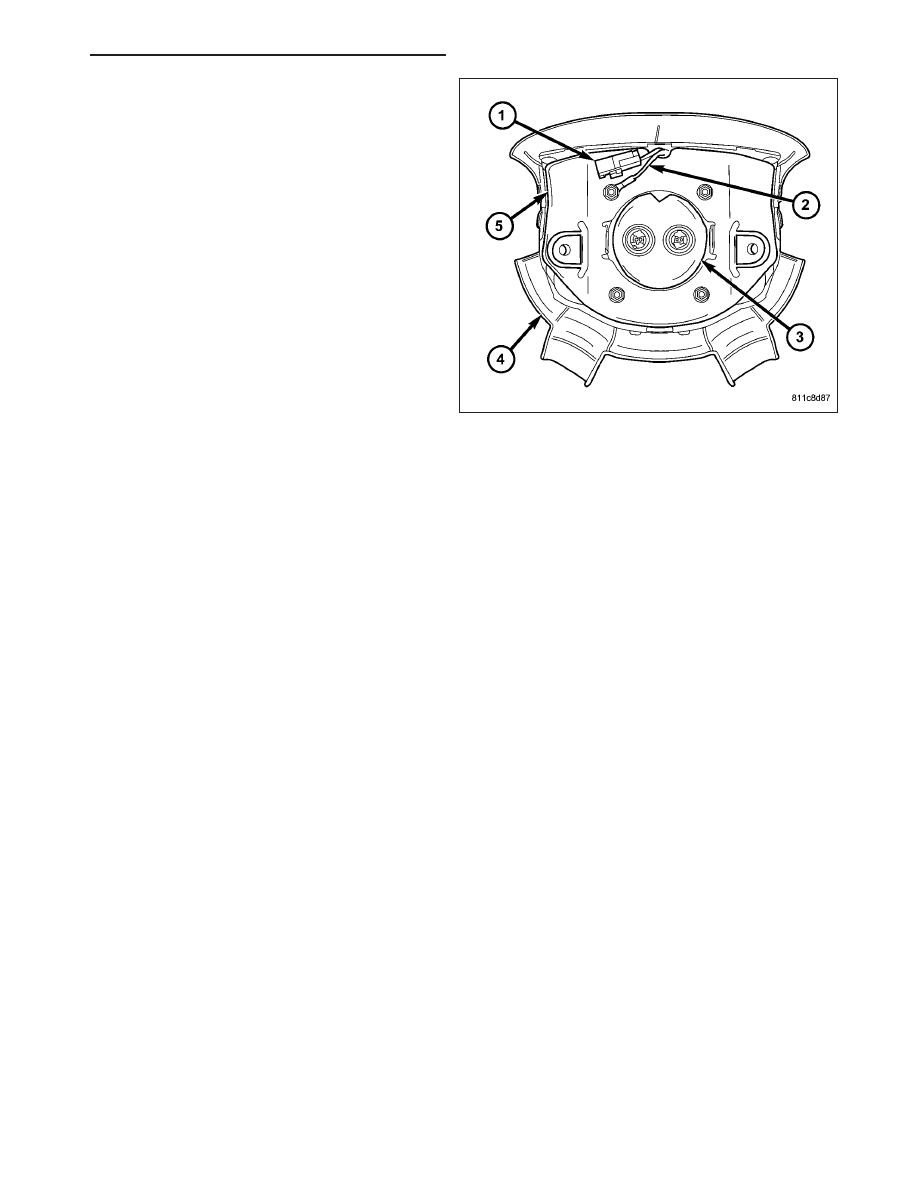Dodge Durango (HB). Manual - part 552

The airbag cushion, housing (5), and inflator (3) are
secured within an integral receptacle molded into the
back of the trim cover (4). The four vertical walls of
this receptacle have a total of twelve small windows
with blocking tabs that are engaged by twelve hook
formations around the perimeter of the airbag housing.
Each hook is inserted through one of the windows and
the blocking tab in each window keeps the hook prop-
erly engaged with the trim cover, locking the trim
cover securely into place on the airbag housing.
The resistive membrane-type horn switch is secured
with heat stakes to the inside surface of the driver air-
bag trim cover, between the trim cover and the folded
airbag cushion. The horn switch ground pigtail wire (2)
has an eyelet terminal connector that is captured
beneath a flanged nut on the upper right inflator
mounting stud on the back of the housing. The horn
switch feed pigtail wire has a black, molded plastic
insulator (1) that is secured by an integral retainer in a
locator hole near the upper right corner of the airbag housing and is connected to the vehicle electrical system
through a dedicated take out and connector of the steering wheel wire harness. Both horn switch wires are routed
through an integral notch in the center of the upper edge of the airbag housing stamping.
The airbag used in this model is a multistage, Next Generation-type that complies with revised federal airbag stan-
dards to deploy with less force than those used in some prior models. A 71 centimeter (28 inch) diameter, radial
deploying fabric cushion with internal tethers is used. The airbag inflator is a dual-initiator, non-azide, pyrotechnic-
type unit with four mounting studs and is secured to the stamped metal airbag housing by four flanged hex nuts.
Two keyed and color-coded connector receptacles on the driver airbag inflator connect the two inflator initiators to
the vehicle electrical system through two yellow-jacketed, two-wire pigtail harnesses of the clockspring.
The driver airbag unit cannot be repaired, and must be replaced if deployed or in any way damaged. The driver
airbag trim cover and horn switch unit may be disassembled from the driver airbag unit, and is available for sepa-
rate service replacement.
OPERATION
The multistage driver airbag is deployed by electrical signals generated by the Occupant Restraint Controller (ORC)
through the driver airbag squib 1 and squib 2 circuits to the two initiators in the airbag inflator. By using two initi-
ators, the airbag can be deployed at multiple levels of force. The force level is controlled by the ORC to suit the
monitored impact conditions by providing one of three delay intervals between the electrical signals provided to the
two initiators. The longer the delay between these signals, the less forcefully the airbag will deploy.
When the ORC sends the proper electrical signals to each initiator, the electrical energy generates enough heat to
initiate a small pyrotechnic charge which, in turn ignites chemical pellets within the inflator. Once ignited, these
chemical pellets burn rapidly and produce a large quantity of inert gas. The inflator is sealed to the back of the
airbag housing and a diffuser in the inflator directs all of the inert gas into the airbag cushion, causing the cushion
to inflate. As the cushion inflates, the driver airbag trim cover will split at predetermined breakout lines, then fold
back out of the way along with the horn switch unit. Following an airbag deployment, the airbag cushion quickly
deflates by venting the inert gas towards the instrument panel through vent holes within the fabric used to construct
the back (steering wheel side) panel of the airbag cushion.
Some of the chemicals used to create the inert gas may be considered hazardous while in their solid state before
they are burned, but they are securely sealed within the airbag inflator. Typically, both initiators are used and all
potentially hazardous chemicals are burned during an airbag deployment event. However, it is possible for only one
initiator to be used during a deployment due to an airbag system fault; therefore, it is necessary to always confirm
that both initiators have been used in order to avoid the improper disposal of potentially live pyrotechnic or hazard-
ous materials. (Refer to 8 - ELECTRICAL/RESTRAINTS - STANDARD PROCEDURE - SERVICE AFTER A SUP-
PLEMENTAL RESTRAINT DEPLOYMENT).
The inert gas that is produced when the chemicals are burned is harmless. However, a small amount of residue
from the burned chemicals may cause some temporary discomfort if it contacts the skin, eyes, or breathing pas-
sages. If skin or eye irritation is noted, rinse the affected area with plenty of cool, clean water. If breathing passages
HB
RESTRAINTS - SERVICE INFORMATION
8O - 477